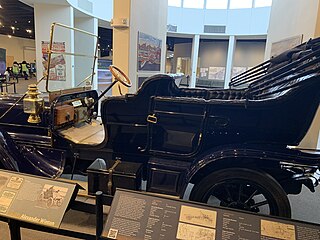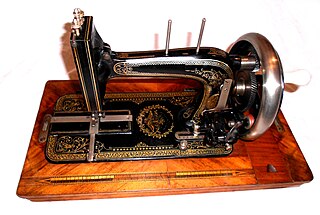
The Winton Motor Carriage Company was a pioneer United States automobile manufacturer based in Cleveland, Ohio. Winton was one of the first American companies to sell a motor car. In 1912 Winton became one of the first American manufacturers of diesel engines.

Stoewer was a German automobile manufacturer before World War II whose headquarters were in Stettin.

Packard was an American luxury automobile marque built by the Packard Motor Car Company of Detroit, Michigan, United States. The first Packard automobiles were produced in 1899, and the last Detroit-built Packard in 1956, when they built the Packard Predictor, their last concept car.
The Pierce-Arrow Motor Car Company was an American motor vehicle manufacturer based in Buffalo, New York, which was active from 1901 to 1938. Although best known for its expensive luxury cars, Pierce-Arrow also manufactured commercial trucks, fire trucks, boats, camp trailers, motorcycles, and bicycles.

L'Aster, Aster, Ateliers de Construction Mecanique l'Aster, was a French manufacturer of automobiles and the leading supplier of engines to other manufacturers from the late 1890s until circa 1910/12. Although primarily known as an engine mass manufacturer the company also produced chassis for coach-works and a complete range of components.
The Lanchester Motor Company Limited was a car manufacturer located until early 1931 at Armourer Mills, Montgomery Street, Sparkbrook, Birmingham, and afterwards at Sandy Lane, Coventry England. The marque has been unused since the last Lanchester was produced in 1955. The Lanchester Motor Company Limited is still registered as an active company and accounts are filed each year, although as of 2014 it is marked as "non-trading".

Baker Motor Vehicle Company was an American manufacturer of Brass Era electric automobiles in Cleveland, Ohio, from 1899 to 1914.

The Pope-Toledo was one of the makes of the Pope Motor Car Company founded by Colonel AA Pope, and was a manufacturer of Brass Era automobiles in Toledo, Ohio between 1903 and 1909. The Pope-Toledo was the most expensive of the Pope range and was the successor to the Toledo of the International Motor Car Company. In 1909 the company was taken over by Richard D. Apperson of the American National Bank of Lynchburg, Virginia.

Stevens-Duryea was an American manufacturer of automobiles in Chicopee Falls, Massachusetts, between 1901 and 1915 and from 1919 to 1927.

The Swift Motor Company made Swift Cars in Coventry, England from 1900 until 1931. It grew progressively from James Starley's Coventry Sewing Machine Company, via bicycle and motorised cycle manufacture. The cars ranged from a single-cylinder car in 1900 using an MMC engine, through a Swift-engined twin-cylinder 7-horsepower light car in 1904, and a 3-litre model in 1913. After the First World War a successful range was sold during the 1920s, but the Cadet of 1930 was its last vehicle as it could not compete economically with volume manufacturers such as Ford and Morris Motors.

The Packard One-Twenty is an automobile produced by the Packard Motor Car Company of Detroit, Michigan, from 1935 to 1937 and from 1939 through the 1941 model years. The One-Twenty model designation was replaced by the Packard 200.

The Brew-Hatcher or B & H was an American automobile introduced in January 1904 at the Chicago Automobile Show and manufactured from 1904 until 1905.

The Renault Voiturette was Renault's first ever produced automobile, and was manufactured between 1898 and 1903. The name was used for five models.
The first Voiturettes mounted De Dion-Bouton engines. Continental tires were used for the car, a make still used for several modern Renaults today.

The Union automobile was based on Lambert's "horseless carriage" gasoline buggy. It had four wheels instead of his 1891 three-wheeled version. The automobile was made by the Union Automobile Company from 1902 through 1905. There were about three hundred Union automobiles made all total.
Lucius B. Packard was an American wheelwright, cabinetmaker and automobile pioneer early in the Brass car era.
Packard Model G is a two cylinder car built in 1902 by the former American automobile manufacturer Ohio Automobile Company that changed name to Packard Motor Car Company in October, 1902.

The Packard Motor Car Company introduced their first four-cylinder engine in 1903 initially as a top level car along with the Packard Model F. It was their only automobile offered and exclusively used a four-cylinder engine from 1903 until 1912 and established Packard as a luxury car maker, and was replaced by the 1913 Packard Six.

RAMI by J.M.K. was a French company that made diecast collector vehicles mostly of classic French automobiles in 1:43 scale. The cars in the line-up represented actual vehicles in the Automobile Museum of the Château de Rochetaillée sur Saône. The models were made in Lure, France, from 1958 to 1969.

Max Wenkel was a German automobile pioneer and inventor.
















